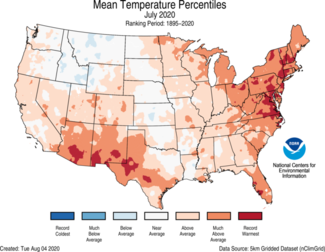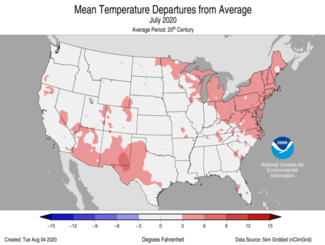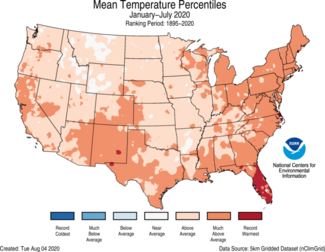
The July 2020 contiguous U.S. temperature was 75.7°F, 2.1°F above the 20th-century average and ranking 11th warmest in the 126-year record. For the year-to-date, the national temperature was 53.6°F, 2.4°F above average, ranking seventh warmest on record.
The July precipitation total for the contiguous U.S. was 2.93 inches, 0.15 inch above average, and ranked in the wettest one-third of the 126-year period of record. The year-to-date precipitation total for the Lower 48 was 19.29 inches, 1.20 inches above average, also ranking in the wettest one-third of the historical record.
This monthly summary from NOAA National Center for Environmental Information is part of the suite of climate services NOAA provides to government, business, academia, and the public to support informed decision-making.
July Temperature
- Above-average July temperatures were present across much of the West, Southwest, central Rockies and from the Mississippi River Valley to the East Coast. Virginia (tied with 2012), Pennsylvania (tied with 1955), and Connecticut (tied with 2013) as well as Delaware, New Jersey, Maryland, and New Hampshire each had their warmest July and month on record with 14 additional states across the South and East having a top-10 month.
- Below-average temperatures were limited to portions of the northern Rockies and central Plains.
- The Alaska average July temperature was 53.3°F, 0.6°F above the long-term mean and ranked in the middle third of the historical record for the state. It was the coolest July since 2014.
- Much of the northern and eastern portions of the state were cooler than average during July.
- Like much of northern and eastern Alaska, Utqiaġvik (Barrow) had a high temperature for the month of 53°F — the second-lowest July maximum temperature in more than 100 years.
- As a result of the cooler temperatures across the Interior during July and the above-average precipitation during June, the Alaskan wildfire season, to-date, is well-below average and has consumed the lowest number of acres since 2008.
- In contrast to the cooler conditions across the northern and eastern portions of the state, southwestern, south central and portions of southeastern Alaska experienced above-average temperatures during July.
- Kodiak had its third-warmest July since 1915, while Cold Bay tied for fourth warmest (since 1950).
- Sea ice across the Chukchi Sea continues its summertime melt phase with a July average extent at 81% of average — the highest coverage since 2016.
July Precipitation
- Above-average precipitation was observed across much of the northern and central Plains as well as the Great Lakes, Mississippi Valley and Gulf Coast. Kansas ranked seventh wettest for July.
- Below-average precipitation fell across much of the West and portions of the Deep South, central Plains, Ohio Valley and Southeast. Arizona ranked sixth driest while Nevada ranked 11th driest.
- The Atlantic Hurricane season has been active with a combination of three tropical storms and two hurricanes named during July. These storms became the earliest fifth, sixth, seventh, eighth and ninth named storms on record in the Atlantic Basin.
- Tropical Storm Edouard formed in the Atlantic Ocean on July 4 off the coast of South Carolina and moved away from land.
- Tropical Storm Fay formed in the Gulf of Mexico on July 9 and, as a depression, proceeded to make landfall over the Florida Panhandle before emerging into the Atlantic Ocean off the Georgia coast, intensifying into a tropical storm and making landfall again near Atlantic City, NJ.
- Tropical storm Gonzalo formed in the eastern Caribbean on July 21 and drifted westward toward the islands of Barbados, St. Vincent and the Grenadines as well as Trinidad and Tobago before dissipating near the Venezuelan coast.
- Hurricane Hanna formed in the Gulf of Mexico on July 23 and tracked westward making landfall on Padre Island, TX as a strong category 1 hurricane. Hanna was the first hurricane of the season in the Atlantic Basin.
- Hurricane Isaias formed in the Caribbean on July 30, bringing heavy winds and rainfall to Puerto Rico before strengthening and moving toward the southeastern U.S.
- Alaska received near-average precipitation during July, but regional amounts varied. Much of the West Coast and portions of the Aleutians, Southeast Interior and Northeast Gulf divisions had drier-than-average precipitation while most of the Panhandle and portions of the Northeast Interior, Central Interior and Bristol Bay divisions received above-average precipitation for the month.
- According to the July 28 U.S. Drought Monitor, approximately 33% of the contiguous U.S. was in drought, which is about seven percentage points higher than what was reported at the end of June. Drought conditions expanded or intensified across parts of the West, South, central Plains, central Rockies, Great Lakes, Ohio Valley and Northeast. Drought intensity lessened across portions of the northern Plains and central to southern High Plains. Outside of the contiguous U.S., drought intensity lessened across portions of Puerto Rico, Hawaii and Micronesia.
Year-to-date (January-July) Temperature
- Above- to much-above-average January-July temperatures were observed across much of the Lower 48. Florida had its warmest year-to-date period on record with New Jersey ranking second warmest and Virginia, Maryland, Delaware, Connecticut, Rhode Island and Massachusetts ranking third warmest. The Florida statewide average temperature for the first seven months of 2020 was 72.7°F, 3.3°F above average. Three of the last four years have been the three warmest January-July periods on record.
- Near-average temperatures were concentrated across portions of the northern Rockies and scattered over the northern Plains and the South.
- The Alaska statewide average temperature for this year-to-date period was 26.0°F, 0.2°F above average and ranked in the middle one-third of the record. It was the coolest January-July since 2012. Above-average temperatures were limited to the northwest West Coast division as well as the Aleutians. Below-average conditions were present across much of the Southeast Interior division and portions of the Northeast Interior, Central Interior, Cook Inlet and Northeast Gulf divisions. Near-average temperatures were present across the vast majority of the state.
Year-to-date (January-July) Precipitation
- Above-average precipitation occurred across portions of the Northwest, central Plains and from the Great Lakes to the Gulf Coast and into the Southeast. Tennessee and West Virginia ranked fifth wettest for January-July with an additional five states ranking in the top-10 wettest for this year-to-date period.
- Below-average precipitation was observed from the West Coast to the Rockies, from the northern Plains to southern High Plains, as well as across portions of the Upper Midwest and Northeast. Colorado had its eighth-driest January-July period on record with 8.00 inches of precipitation, 3.17 inches below average.
- Year-to-date precipitation across Alaska ranked at the top of the middle third of the historical record. Much of the Alaskan mainland received above- to much-above-average precipitation over the first seven months of 2020, while the Aleutians, Cooks Inlet and Northeast Gulf regions received below-average precipitation.










